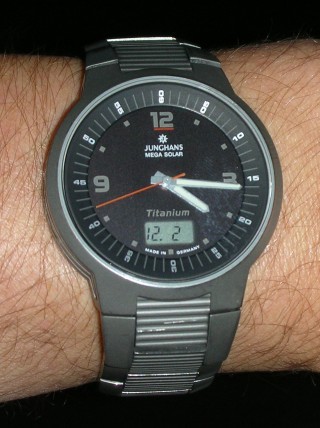
Here's a photo of the watch I've been wearing the past few years. It's solar-powered (no annual battery replacement), quartz-based (accurate to a second a day), radio-controlled (resets itself most nights from WWVB), with titanium band and case (very lightweight).

But how well does is really work, you wonder?
Below is a plot of the performance of this watch measured over a day. Depending on your point of view the watch keeps really good time, gaining only 0.16 seconds in a day. That's a rate error of 160 ms / 86400 seconds = 1.8 × 10-6 = 1.8 ppm; about a second a week. Alternatively you could say the watch keeps really bad time, suffering an error of almost 2 microseconds every second! If you measure close enough you will see this. Anyway, here's the plot:

Not bad, eh? But why are there three line segments; why does the time jump near the beginning and the end of the plot?
Since this is a radio-controlled watch the performance gets more interesting when you collect many days of data. This, because you can actually see the watch resetting itself every night. Below is a ten-day performance plot.

The obvious thing to note is that the clock gets reset once a day, in this case shortly after midnight each day.
Another thing to notice is that the watch isn't off by 0.16 seconds every day. Some days a little more, even up to 0.18 s; other days quite a bit less, maybe only 0.11 s.
Notice also that the watch doesn't get reset to perfect time each midnight. Perhaps based on the quality of radio reception, or some internal limits to its ability to synchronize, it starts the day anywhere from 0.3 s late to 0.1 s early.
Taking these offsets into consideration you can see that the clock rate also varies. Some days the watch gains about 0.16 s, other days maybe only about 0.13 s. This rate variation at the ppm level is not uncommon.